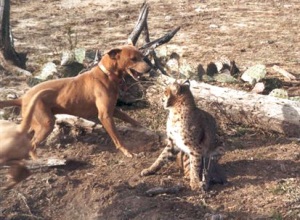Lacys were developed to be an all-around working dog. Our new series, Lacys at Work, explores the numerous jobs the breed excels at.
What is a trap line?
Trapping is a form of predator control. Trappers set up lines for coon, coyote, fox, bobcat and hogs that are killing livestock, destroying crops and causing habitat damage. Many professionals use a long chain and drag on their traps. This lets the animal run into the brush, where they feel hidden and settle down faster, preventing further physical damage and stress. The drag will usually create a good trail to follow, but if the ground is rocky or has a lot of dead grass, the drag will leave little or no sign. This is where the dog comes in.
How do trap line dogs work?
Starting where the animal was caught, the dog works the track to find the trapped varmint. Once they find their quarry, they must bay up to alert the trapper to its location and keep the animal in one place. So the dog must learn to trail any varmint that is in the trap. They also need to be able to deal with anything the trapper catches, which can range from an ornery wild boar to a treed black bear. With a competent dog controlling the situation, the trapper is able to get close to quickly dispatch the animal.

Why do Lacys make good trap line dogs?
Lacys were bred to have all the skills and traits necessary for a good trap line dog. They are extremely motivated by a high prey drive. Their intelligence means they can learn to discriminate between different tracks and animals, leaving deer and livestock alone unless they are caught in a trap. Lacys are also gritty enough to deal with a variety of predatory animals. Their compact size allows them to get into thick brush and still control whatever they are baying.
Where can I learn more about trapping?
There are several organization that support trappers. The Texas Trappers and Fur Hunters Association and the National Trappers Association work to defend and promote ethical trapping. Furbearers Unlimited is known for their habitat conservation efforts. But one of the best ways to learn about running trap lines is to talk to a mentor. You can find trappers that work with Lacys at the National Lacy Dog Association bulletin board.
This article was written by Jimmy Brooks, president of the National Lacy Dog Association. Jimmy is a full-time trapper in Texas and uses his Lacys to run trap lines year round. His views are based on 52 years of breeding and handling true working Lacys, not house pets, which can and will do it all.


4 comments
January 8, 2009 at 4:03 pm
links for 2009-01-08 | hxf148
[…] Lacys at Work: Trap Line Dogs « National Lacy Dog Association […]
January 11, 2009 at 9:05 pm
Odd Moments in the Animal Kingdom - Page 10
[…] And this flickr set of dogs cornering a coyote has some great pics like this one: This blog post explains more about what they are doing. And there is, of course, an ass hole: A walrus doing […]
February 16, 2009 at 10:03 pm
The Lacy Dog: One Breed the Fancy can’t touch! « Retrieverman’s Weblog
[…] that soup, they created their own hog dog that could also run other varmints. They are also used as trapline dogs. This is one of those dogs that was bred for its purpose, and only dogs that were good for that […]
March 12, 2011 at 2:28 pm
Registry Cleaners Do They Work – The Hidden Trap » Kari Shaffer
[…] Lacys at Work: Trap … chain and drag on their traps. This lets the animal run into the brush, where they feel hidden … How do trap line dogs work? Starting where the … National Lacy Dog Registry; NLDA on … […]